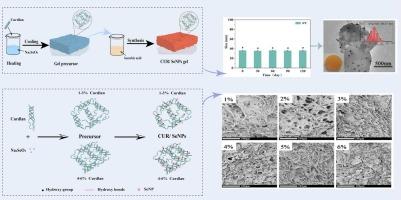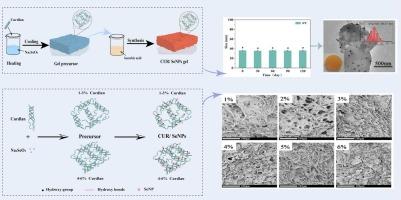In-situ synthesis and evaluation of Curdlan-based SeNPs composite hydrogel: effect of stability and sustained release
IF 9.8
1区 农林科学
Q1 CHEMISTRY, APPLIED
引用次数: 0
Abstract
This study used Curdlan (CUR) hydrogels as templates to stabilize selenium nanoparticles (SeNPs), focusing on their stabilization mechanisms, storage stability, release behavior, and digestive stability. Results showed that CUR-stabilized SeNPs were spherical, uniformly dispersed, and had an average size of 36.0 ± 2.5 nm. Increasing CUR concentration improved the system's water-holding capacity, reduced porosity, and formed a denser network structure, which helped stabilize the SeNPs. Fourier-transform infrared (FT-IR) and rheological analysis indicated that hydrogen bonds contributed significantly to SeNPs stability. The optimal network structure formed at 4 % CUR concentration. At 4 °C, the SeNPs remained uniformly dispersed for 120 days with an average size of 36.0 ± 0.5 nm. The CUR/SeNPs hydrogel showed sustained release, increasing from 1.68 % in simulated gastric fluid to 18.19 % in intestinal fluid. The release behavior conforms to the Korsmeyer-Peppas model. Moreover, CUR/SeNPs hydrogel effectively scavenges DPPH radicals, and its efficiency increases with the amount of released selenium.


基于curdlan的SeNPs复合水凝胶的原位合成与评价:稳定性和缓释效果
本研究以Curdlan (CUR)水凝胶为模板稳定硒纳米颗粒(SeNPs),重点研究其稳定机制、储存稳定性、释放行为和消化稳定性。结果表明,cu稳定的SeNPs呈球形,分散均匀,平均尺寸为36.0 ± 2.5 nm。增加CUR浓度提高了体系的持水能力,降低了孔隙度,形成了更致密的网络结构,有助于稳定senp。傅里叶变换红外(FT-IR)和流变学分析表明,氢键对SeNPs的稳定性有显著影响。当CUR浓度为4 %时,形成最优的网络结构。在4 °C时,SeNPs保持均匀分散120 天,平均尺寸为36.0 ± 0.5 nm。CUR/SeNPs水凝胶表现出缓释,从模拟胃液中的1.68 %增加到肠液中的18.19 %。释放行为符合Korsmeyer-Peppas模型。此外,CUR/SeNPs水凝胶可以有效清除DPPH自由基,且其效率随硒释放量的增加而增加。
本文章由计算机程序翻译,如有差异,请以英文原文为准。
求助全文
约1分钟内获得全文
求助全文
来源期刊

Food Chemistry
工程技术-食品科技
CiteScore
16.30
自引率
10.20%
发文量
3130
审稿时长
122 days
期刊介绍:
Food Chemistry publishes original research papers dealing with the advancement of the chemistry and biochemistry of foods or the analytical methods/ approach used. All papers should focus on the novelty of the research carried out.
 求助内容:
求助内容: 应助结果提醒方式:
应助结果提醒方式:


